Latin American Silhouettes
2 total works
The 2,000-mile-long international boundary between the United States and Mexico gives shape to a unique social, economic, and cultural entity. The U.S.-Mexican Border in the Twentieth Century is the first comprehensive treatment of the fascinating evolution of the region since the beginning of the twentieth century. Drawing on the findings of the classic literature, new research, and current data, David E. Lorey considers the different roles that external influences and internal developments have played in shaping the border. Exploring the evolution of a distinct border society, Lorey traces broad themes in the region's history, including geographical constraints, boom-and-bust cycles, and outside influences. He also examines the seminal twentieth-century events that have shaped life in the area, such as Prohibition, World War II, and economic globalization. Bringing the analysis up to the present, the book assesses such divisive issues as the distinction between legal and illegal migration, trends in transboundary migrant flows, and North American free trade. Informative and accessible, this valuable study is ideal for courses on the U.S.-
Mexico borderlands, Chicano studies, Mexican history, and Mexican-American history.
Mexico borderlands, Chicano studies, Mexican history, and Mexican-American history.
The U.S.-Mexican Border into the Twenty-First Century
by Paul Ganster and David E. Lorey
Published 19 July 2007
Systematically exploring the dynamic interface between Mexico and the United States, this comprehensive survey considers the historical development, current politics, society, economy, and daily life of the border region. Now fully updated and revised, the book analyzes the economic cycles and social movements from the 1880s that created this distinctive borderlands region and propelled it into the twenty-first century and a globalizing world. Richly illustrated with photographs, maps, and tables, the book concludes with an analysis of key borderlands issues that range from the environment to migration to national security.

